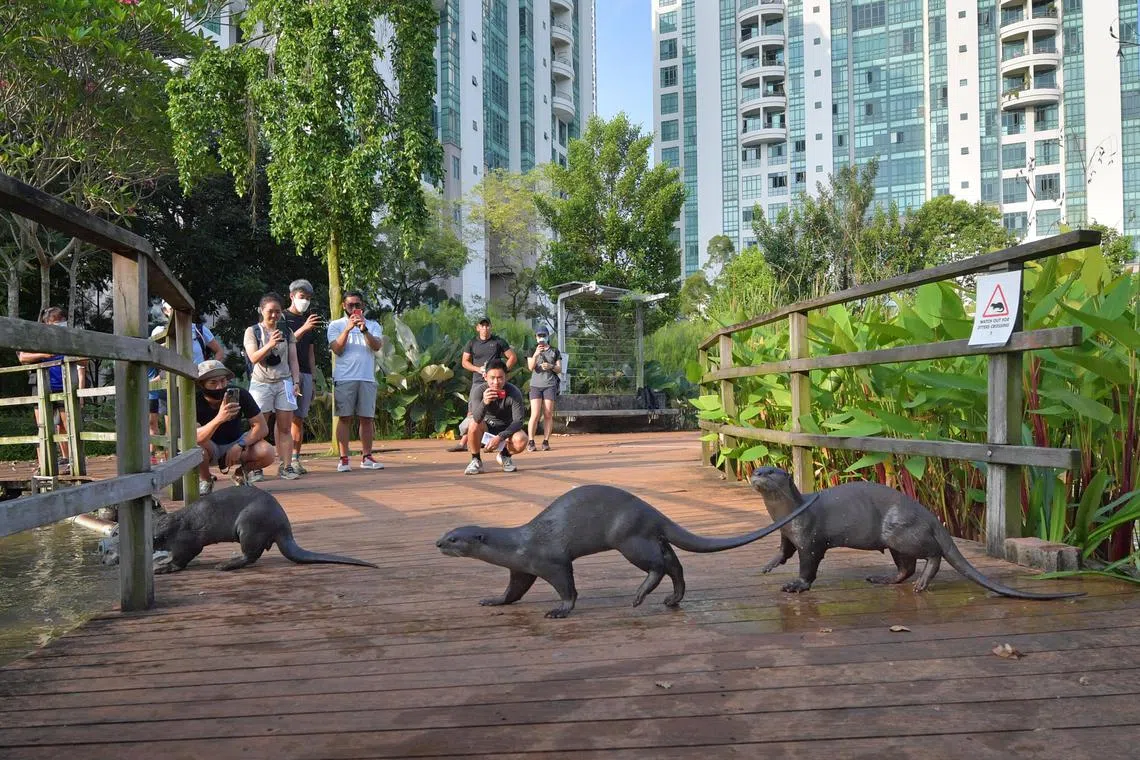Otters ate your koi? Here’s what you can do to avoid animal-human conflict
Sign up now: Get ST's newsletters delivered to your inbox

The National Parks Board reported that it had received about eight feedback cases on otters per month since 2022.
PHOTO: ST FILE
Follow topic:
SINGAPORE – Otters have been making a splash on social media in recent months, with incidents of them dipping their paws into residents’ pricey koi collections and munching on the fish.
There have also been reports of people getting bitten by the animals in the past few years.
The Straits Times spoke to experts and wildlife enthusiasts to find out the causes behind such incidents, and ways in which people can better coexist with wild animals like otters on our small urban island.
Has the otter population increased?
The commonly seen smooth-coated otter is one of two species found here. It is larger than the small-clawed otter, which can be found in mangroves in western Singapore and on Pulau Ubin. Recent reports indicate that there are about 170 smooth-coated otters here, up from about 80 in 2017.
The medium-sized mammals, which are listed as critically endangered in Singapore, can be seen in a few parts of the island, including places like Bishan-Ang Mo Kio Park, the Singapore Botanic Gardens and Sungei Buloh Wetland Reserve.
They are popular with not just amateur photographers but also ordinary residents, who take videos and photos of the animals and post them on social media platforms.
But experts advise against getting too close to otters because this can startle the wild animals and cause them to attack.
On April 4, 2022, a man was bitten by an otter in Kallang Riverside Park.
Experts said expanding urbanisation has led to further clashes between humans and wildlife. Animals like wild boars and otters wander into residential areas in search of food. This has sometimes led to unhappiness and complaints, which are aired on social media platforms.
The National Parks Board (NParks) said that each month since 2022, it has received about eight cases of feedback on otters foraging for food in residential estates.
What should people do when they encounter otters?
A spokesman for otter photography Facebook group Myottermelon told The Straits Times that otters are generally not aggressive and do not attack people without reason.
“Often, people are bitten because they go too close to them, either trying to take photos with their phones or to touch them like cats and dogs,” she said.
She added that some dog owners have been seen “challenging the otter family as they think their dogs can fight them”.
“These actions may trigger a reaction from the otters to defend themselves and biting incidents may happen,” she said.
Otters feed on fish, so fence up your koi
On July 25, Shin Min Daily News reported that about five otters had eaten six koi fish kept outside a Housing Board flat in Bukit Purmei. The home owner said he kept the pricey fish in a tank outside his ground-floor unit. In another incident on March 2, otters were reported to have feasted on 30 koi fish at a man’s house in Chuan Drive.
The Otter Working Group – which includes representatives from NParks, national water agency PUB, Mandai Wildlife Group, the Animal Concerns Research and Education Society and other organisations – has advised home owners keeping ornamental fish to take steps to stop otters from entering their homes. These include sealing gaps in fences and gates with mesh, and putting up otter-proof barriers for ponds.
Mr How Choon Beng, director of wildlife management and outreach at NParks, said: “NParks takes action to pre-empt or mitigate human-otter conflict where possible. This is particularly so for areas where the public may come into closer contact with otters. These actions include raising awareness through outreach and signage.”
The Otter Working Group also works with home owners and estate managers to put in place wire mesh and other types of barriers to block access to private spaces and prevent otters from entering.
Get more information
Dr Shawn Lum, an ecologist and immediate past president of the Nature Society (Singapore), said there should be programmes “to coax people out of fearing animals, or to at least make some people more accepting of our wild neighbours”.
Such programmes could be in the form of organised walks, gardening activities for more people, and talks and discussions with residents about local wildlife, he said.
While otter-related incidents may seem frightening, an NParks spokesman said otters are generally shy and will not attack unless provoked or when they feel threatened.
“When encountering otters, it is best to observe them from a safe distance and avoid getting close to or cornering them, especially when there are pups, as the adults can be protective over their young when approached by humans,” the spokesman said.
He added that resident engagement activities are carried out early in areas where otters are sighted, to show people how to respond appropriately to encounters.
NParks has also released an advisory


